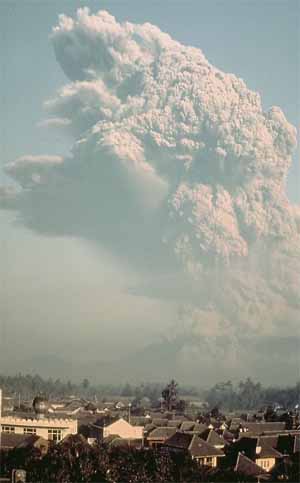3rd Volcano Erupts, Villiagers in Total Darkness
2005 04 18
By Ahmed Ali Amir | Reuters
 MORONI (Reuters) - A volcano erupted on the Indian Ocean Comoros islands on Sunday, forcing hundreds of villagers to flee in fear of poison gas as the crater spewed ash and flung boulders over molten lava,witnesses said. MORONI (Reuters) - A volcano erupted on the Indian Ocean Comoros islands on Sunday, forcing hundreds of villagers to flee in fear of poison gas as the crater spewed ash and flung boulders over molten lava,witnesses said.
Darkness enveloped homes near the summit of Mount Karthala as black rain pounded the mountainside,sparking panic among residents afraid of the kind of noxious fumes that seeped from the volcano a centuryago, killing 17 people.
"Villagers are in total darkness, gritty rain is falling and visibility is zero," a resident from the village ofIdjinkoundzi on the western flank of Mount Karthala, who gave his name as Charif, told Reuters by telephone.
The 2,361-metre (7,746-ft) Mount Karthala and its forested slopes form most of the land mass of GrandeComore, the main island in the Comoros chain which lies 300 km (190 miles) off east Africa, and which haswitnessed periodic eruptions.
Jean Marc, a pilot with Comoros Aviation, who flew over the summit, said: "I saw the start of a lava flow, butfor the moment it's confined to the inside of the volcano."
Families from the villages of Trelezini and Tsorale piled into taxis and buses and headed for the capitalMoroni, which lies on the west coast of Grande Comore, about 15 km (9 miles) from Karthala's crater, whichtowers above the Indian Ocean.
"Dust is still falling, with torrential rains and high winds sweeping across the region," said Ibrahim Youssouf,a resident in the town of Fomboni on the southeastern coast of Grande Comore who visited the scene.
Defence Minister Houmed Msaidie warned residents to avoid the area to avoid the risk of exposure todangerous gases.
"The volcano has started to erupt and two regions are exposed for the moment, Dimani and Badjini,"Msaidie told reporters. "We cannot rule out the risk that gases could escape and it would be wise to notapproach the zones at risk."
Dry river beds turned to raging torrents as rainwater coursed down the volcano's slopes, according toresidents.
"The ground has started trembling and we have seen cracks appearing," said one official near the flanks ofthe volcano, which are frequently draped in white cloud.
Residents who made the two hour hike to the summit from Idjinkoundzi said they had seen parts of the sidesof the 3 km (1.8 mile)-wide crater collapse and enormous chunks of rocks hurled for several kilometres.
RESIDENTS URGED TO EVACUATE HOMES
Comoran officials urged residents to evacuate homes on the mountainside nearest to the to the peak, ablack crag that soars above vanilla vine plantations thriving on the fertile slopes.
Msaidie said authorities were checking for contamination after locals reported a grey discolouration inwater.
"Measures have been put in place to analyse the water ... and tell the population about any risks as soon aspossible," he told Reuters.
Vulcanologists at the archipelago's Centre for Documentation and Scientific Research said they weremonitoring the situation.
"For the past week Karthala has been showing signs of agitation, but in the past 24 hours this agitation hasbecome generalised and the main crater is erupting," researcher Hamidou Soule told Reuters.
"For the moment the eruption is confined to the inside of the crater, which is spewing ash and blocks ofstone."
Karthala last erupted on July 11, 1991, when an explosion at the summit hurled boulders for severalkilometres but caused no injuries.
A fiery torrent of molten rock dribbled from a fissure on the side of Karthala during the previous eruption inApril 1977, destroying 300 houses in the village of Singani, although locals managed to flee to safety.
Noxious fumes seeping from cracks suffocated 17 people in 1903. A year later, one person perished in alava flow. In the mid 19th Century, a lava flow passed near to the capital.
Earth Changes TV
Article From: http://www.earthchangestv.com/secure/2005/article_7649.php

|
